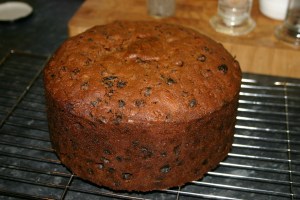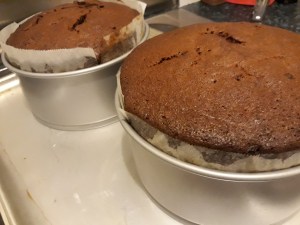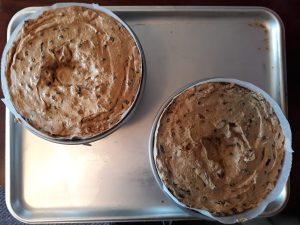
Christmas cake, Christmas pudding, mince pies – if you don’t like dried fruit you are in trouble at Christmastime!
The Christmas cake as we know it comes from two Christian feast days: Twelfth Night and Easter.
When families in the sixteenth century made their Christmas puddings for the big day, they would often use some of the mixture, with the addition of flour and eggs, to bake and eat for Eastertime. These were obviously rather rich families. It was liked so much that the rich fruitcake was made for Christmas too. We also dropped it from the Easter menu for some reason.
The addition of the marzipan and royal icing (see here for recipes) came much later when a cake was banned from Christmas. The last day of Christmas is Twelfth Night (the 5th of January) and it used to be traditional to make a Twelfth Night cake that contained almonds and was covered in marzipan. Oliver Crowell, the Lord Protector of England, and the other Puritans banned the feasting on that special day in the 1640s (he also banned mince pies as well) complaining that there was too much excess. Christmas Day remained a public holiday and some feasting was allowed, so people simply made their Christmas cake and covered that in marzipan instead, and so the Christmas cake was born.
Britain’s biggest ever party-pooper: Oliver Cromwell
You don’t have to cover it with the marzipan and royal icing though, in Yorkshire (my home county) it is popular to eat the Christmas cake with some nice cheese such as Wensleydale or Cheddar instead.
I love Christmas cake, so I thought I would give you the recipe I always use – it is adapted from Jane Grigson’s English Food (click here to see my other pet project) – and it has never failed on me. As I said a couple of posts ago, if you want to eat top-quality food at Christmas, you need to make your own, or spend a fortune at Harrod’s. Plus the cake is made well in advance – I usually make mine 6 weeks before Christmas so it can mature. Once you’ve cooked it, you only have to feed it with a little brandy to make it nice and moist.
This recipe is of course for an English-style Christmas cake; the Scottish, Welsh and Irish have their own versions, all in a similar vein, but with a few differences. I’ll blog about them at some point.
It makes one hefty 8 inch/20 cm cake, for a smaller cake, half the amounts and bake in a 6 inch / 15 cm tin for 2 1/2 hours.
Ingredients:
900 g mixed dried fruit (currants, raisins and sultanas)
125 g of whole roasted almonds (or hazelnuts or walnuts, or a mixture)
125 g chopped candied citrus peel
125 g rinsed glacé cherries quartered or left whole
300 g plain flour
1 1/2 tsp mixed spice
the grated rind of a lemon
250 g salted butter, softened
250 g soft dark brown sugar
1 tsp vanilla extract
1 tbs black treacle (or molasses)
4 eggs
1/2 tsp bicarbonate of soda
1 tbs warmed milk
brandy
Preheat your oven to 140⁰C (275⁰F).
Begin by mixing all the dried fruit, almonds, candied peel and cherries in a large bowl. Next, sift in the flour, turning in and coating the fruit, then mix in the spices and fresh lemon rind.
Now cream the butter sugar in a separate bowl, then mix in the vanilla and black treacle. Beat in four eggs one by one until incorporated, and the mix in the fruit and the flour. For the final stage, dissolve the bicarbonate of soda in the warmed milk, stir it in, and then add enough brandy to slacken the mixture slightly, so that it achieves a dropping consistency – you don’t want a dry cake, now do you?
Line an eight inch cake tin with greaseproof paper and pour the mixture in, hollowing the top a little to compensate for it rising in the oven.
Cover with a layer of brown paper to prevent scorching and bake for 3 to 3 ½ hours. Test it after 3 hours with a skewer. When done, leave to cool in its tin overnight. Wrap in greaseproof paper or foil and keep in an airtight container.

Ideally, the cake should sit for at least a month to mature, but 2 or 3 weeks is also fine. Whilst it sits, you need to feed it with a sprinkle of 2 or 3 tablespoons of brandy, turning the cake each time it is fed.
The cake is ready to eat when sufficiently fed and matured, however, you might want to add a layer of marzipan and royal icing.
If you like the blogs and podcast I produce, please consider treating me to a virtual coffee or pint, or even a £3 monthly subscription: follow this link for more information.



Interested that like me you don’t soak your fruit in alcohol but rely entirely on the feeding. Seems to be very localised these days not to add brandy or rum to the mix. Maybe a Yorkshire thing? Loncolnshire grandmother added alcohol to mix, Yorkshire one didn’t.
Wish I could get decent Wensleydale here – only the horrid stuff with fruit in seems to make it to Dublin. Hoping to get to England next week and if so may head for Hawes. Wensleydale with fruit cake and cheddar with apple pie in our house.
LikeLike
I really dislike cheese with fruit bits in – I believe their presence is hiding a multitude of sins…
I go to Hawes every now and again to stock up on various foodstuffs. Don’t get the chance much these days…
I’ve always added alcohol to my cake – it’s whatr makes it. It makes it so moist and moreish. If there’s no alcohol is just isn’t that nice.
LikeLike
That recipe looks very like what Americans call fruit cake, the butt of many jokes. Apparently no one really eats it, so it just gets regifted year after year, or used as a door stop. But if you like it, it must be good. What mixed fruits? What are glace cherries? No suet? Do you guys have anything like the German stollen I always make at Christmas? Isn’t there a Christmas pudding that gets steamed and does have suet?
LikeLike
Mixed fruits means a mix of raisins, currants and sultanas specifically. You buy them aready mixed in Britain sometimes with the citus peel in there too. Glace cherries are candied cherries. There’s no suet here – suet is no good for cakes.
The Christmas pudding is what has the suet and is steamed. The recipe above is basically the cake version of the steamed pud.
LikeLike
also… the nearest to stollen is probably a Twelfth Night cake or a simnel cake (though the latter is made for Easter)
LikeLike
Pingback: Christmas is coming… | British Food: A History
Oliver Cromwell was a huge party-pooper! Unfortunately, here in America we got stuck with a lot of Purtians. One of my British history professors always said that the Puritans were the people who were too uptight even for England. I guess it’s a little consolation for me that my father’s family settled in Virginia and not Massachusetts! Anyway–
I love Jane Grigson’s books, but I don’t have a copy of English Food yet. Joan’s right about the “fruitcake” appellation. We do call almost any cake with dried fruits and spices a fruitcake and they do have a bad reputation. The ready-made ones are awful and grandmas tend to use this abhorrent stuff called “fruitcake mix” (http://www.amazon.com/Paradise-Extra-Fancy-Fruit-Ounce/dp/B002V0LDX0). It’s terrifying. I love a proper fruitcake, though. I don’t think many people here have actually had one. 😦
LikeLike
have you checked out my other blog? i am cooking the whole of English Food, check it out: http://www.neilcooksgrigson.blogspot.com
I think you are right about bad fruit cakes. You just have get a good recipe that doesn’t skimp on the fruit or booze. Anything bought usually has many corners cut.
LikeLike
Pingback: “Out of the strong came forth sweetness…” | British Food: A History
Pingback: On the Eighth Day of Christmas, The Country Kitchen baked for me… | The Country Kitchen
Cheers for the link! Great post!
LikeLike
Try substituting some of the dull mixed fruit for glace papaya, mango and pineapple. Truly scrumptious, and moist.
LikeLike
Thanks for your post, Jenny. When I lived in the USA, the mixed fruit contained some of the fruit you mentioned I found them far too sweet! I don’t think our regular dried fruit is dull, but I do know many people disagree!
LikeLike
Lovely cake! I line the baking tin on the inside with 10+ layers of news paper and then Aluminium foil to avoid direct heat to the cake from the metal tin. This results in no chrispy dried out sections.
If the mix are to runny, the fruit settles to the bottom … not good…. keep the mix stiff.
LikeLike
Yes the cake mixture doesn’t have to be too runny – it’ll become moist as you feed it brandy. Coating the fruit in the flour helps stop it sinking – an important step!
Thanks for your comment!
LikeLike
Pingback: Simnel Cake | British Food: A History
Pingback: A British Weihnachten – The German Way & More
Pingback: Twelfth Night Cake | British Food: A History
I enjoy this recipe and it is the closest to the ingredient list I found in my Grandmother’s and Mother’s recipe books. My Grandmother was a cook in homes in Brighton until her marriage in 1913. The first year I made this cake it turned out beautifully but since then I have had a few issues. This year the cake rose on the edges but sunk in the middle. I baked at 275 F and did not open the door for the entire 3 hours. When I checked the cake the tester came out clean. Would the problem be overbearing the batter or when combining the fruit with the batter? I used an electric mixer and know that my Mother always mixed by hand. I lined the baking tins with greased heavy brown paper with a collar rising above the rim of the tin. My Grandmother’s recipe calls for 1/8th cup of orange juice in the batter. I baste the cake with brandy after it has baked. Any suggestions would be appreciated as I plan on baking another cake this weekend.
LikeLiked by 1 person
Hi Janet. I too use an electric mixer but you must be careful not to over mix it when the flour is added. Are you using a raising agent in the cake? The main reason cakes slump in the middle is that the oven door is opened during the early stages of baking (or heat cuts out?) or there is too much sugar. Are your scales accurate?
LikeLike
Thank you for your reply. I do use bicarbonate of soda, the same amount as in your recipe. My Grandmother’s called for it to be dissolved in a small amount of warm water rather than milk and I use your directions for amount of water. I checked water temperature with a thermometer. I will hand mix at the final stage rather than use the mixer and hope it rises in the centre.
LikeLiked by 1 person
Use the mixer to really fluff up the butter and sugar at the beginning but then switch to hand/spoon for mixing in the flour. Hopefully you’ll be grand! Let me know how you get on
LikeLike
Thank you for your quick reply to my questions. I do use bicarbonate of soda (same amount as this recipe) dissolved in a bit of warm water (as I did not have an amount of water to use I followed this recipe). I use 5 Roses AP flour. The oven was not opened during baking and no power failure happened. I will hand mix the batter with the fruit as my Grandmother and Mother did in the past and hope that resolves the issue. One person suggested that I let the batter rest before baking to allow any extra air to escape. I checked my scale and it seems accurate.
LikeLike
Pingback: Making the Christmas cake – Allendale Diary
Pingback: This Christmas, let’s be thankful for trade and innovation. And cake. – HNM
Pingback: Xmas Cake – Curious Foodies
Pingback: Happy New Year! | British Food: A History
Pingback: The Return of the British Cheese Industry | British Food: A History
Pingback: Black Bun (Scotch Bun) Part 1: History | British Food: A History